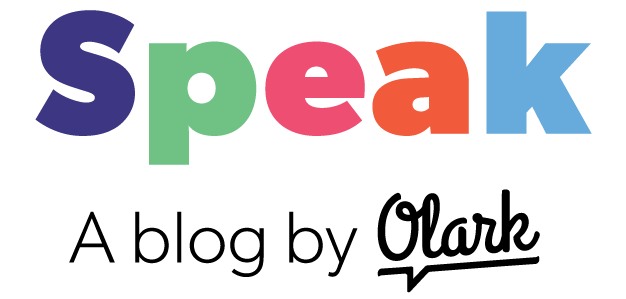All-hands support is an Olark institution. We’ve been sharing responsibility for chat and email support across everyone on our team — everyone, including developers, designers, marketers, and our CEO — since our company was founded in 2009. It hasn’t always been easy, but it’s always been worth it. How have we made it work?
All-hands support is an Olark institution. We’ve been sharing responsibility for chat and email support across everyone on our team — everyone, including developers, designers, marketers, and our CEO — since our company was founded in 2009. It hasn’t always been easy, but it’s always been worth it. How have we made it work?
Way, way back, in the early days, when Olark was just four founders living and working together in a house in the Bay Area, the only way to handle customer inquiries was to share the load. Just about any founder can identify with that.
But once growth was moving along well enough to hire an employee, Matt, Ben, Roland and Zack found Andrew to answer all those emails and chats. Over time, though they realized they were missing out. What did people think of that new feature? How did they react to the dashboard change? Were customers facing challenges that Olark wasn’t addressing?
As great as it was to have lots of heads down time to make Olark better, our founders still wanted to feel connected to their customers. So the Olark founders logged back into chat. At least once a week, while waiting for code to compile, or between launching big projects, they listened to their customers. They learned what made Olark great, as well as what really needed to improve.
But Olark, that was years ago! What about 2019?
That...is a most excellent question. AHS is still a core part of our company philosophy, but it's continued to evolve as we add new team members and grow our company to take on on new challenges.
How Olark does All Hands Support in 2019
Today, our support team lead (shoutout to Emily) manages All Hands Support as an ongoing project. When we welcome a new hire, and they've completed onboarding into their primary role, they get to spend a week with Emily learning the ropes of support.
During their training week, the new Olarker learns about the intricacies of our product, our policies, and our support philosophy. They learn about our billing, email, and chat systems. And they learn how to juggle it all to make customers happy.
From there, Olarkers are asked to dedicate at least four hours per month to frontline support. They have lots of flexibility when it comes to scheduling that time — they can just pick a morning or afternoon and hop on chat, or they might choose to cover for a full-time frontliner's vacation. Regardless of the timing, the support team loves the backup. Additionally, all Olarkers cover at least two one-hour holiday email shifts each year, which allows us to continue supporting our customers via email when we're otherwise closed for a holiday.
How do Olarkers feel about spending time on support? Well, in short, they love it. Taking a chat or email shift is a nice break from more isolated, heads-down responsibilities, and positively impacts everyone's understanding of our customers — which, in turn, positively impacts our product. A developer might chat with a customer and discover a small tweak that quickly becomes a widely-appreciated product improvement.
If All Hands Support is so great, why don't all companies do it?There are lots of possible objections to All Hands Support. Some companies have said that it devalues the incredible amount of skill it takes to do quality support, while some fear letting anyone at the company answer customer inquiries or handle sensitive interactions. And some think it just takes too much work.
Those considerations are real. But at the end of the day, we feel that support is an integral part of Olark's culture. By hiring for our values, and making it clear upfront that support is part of the gig, we select for employees who believe in the value of talking to end users. We absolutely respect the skills it takes to do support well (actually, our full-time support team is the object of a certain amount of awe...), and we believe it's worth the effort to train everyone in the basics.
Training your team for All Hands Support
We want to make it easier for other teams to kick off their own All Hands Support programs — and to that end, we’re excited to share our training schedule and the basic organization of our training materials.
We don’t expect you to launch a full size AHS initiative and get everyone trained at once, and we don't expect you to follow our process exactly. We believe starting small, and customizing a timeline and materials to meet your own needs, is the best way to go. And if you want to chat more about how to make AHS work, well, you know how we feel about chatting!
Training timeline

Having a clear training schedule for All Hands Support training is critical. You’re pulling someone away from their regular team duties, so you need to be able to clearly communicate the time commitment to the employee, their team, and their manager. A timeline also makes it clear to the trainee how much time they have to absorb information, so that if they fall behind, they can ask for help sooner rather than later.
Here's a basic outline of the timeline we follow at Olark:
- Toward the end of a new employee's regular onboarding program, we schedule a 1:1 for them with the full-time support team member who will be managing their AHS training. The trainer explains the basics of AHS, outlines what will be covered during the training, and answers questions.
- AHS training typically takes about a week of half days, so role-specific work isn’t fully interrupted.
- The first few days are focused on the workbook (see below), and the last couple days are spent doing support shifts with a training buddy. Usually the the trainer and trainee hop on a call together and the trainee does a support shift with the help of the trainer.
- Once AHS training is complete, the new AHSer is encouraged to schedule a support shift in the near future so their skills don’t get rusty.
Training Workbook

Our All Hands Support training workbook serves two main purposes:
The first is to convey information in a convenient, standardized way for all trainees. While training does include plenty of face-to-face time (in our case, via videoconference), people learn in a variety of ways. Using the workbook provides a way for people to find their own answers, and digest the information aurally and visually.
The second purpose is to serve as a personal reference. Learning to support a product is pretty intense, and we know no one can absorb it all in a week. A workbook is another place to look for answers to the basic questions that will come up in a support interaction.
Our workbook is an online wiki organized in the following general fashion. You’ll want to customize your workbook to your product and support methods, of course.
We start with this message to new trainees:
How this workbook works:
This workbook is for you to jot down notes, questions, project ideas, basically a way to track your experience with AHS training.
This workbook belongs to you! Feel free to add/edit/change as you see fit, you know your learning style and what works best for you.
We are continuously looking for ways to improve our AHS training and your input is greatly appreciated! If there’s something you think we should add or change, please make a note of it :)
Before you start:
- Make sure you have access to the AHS calendar
- Check out the guide at the end of this workbook for what an average AHS shift is like.
- What are some shortcuts/text macros that might work for you? You’ll be sending a lot of links to customers, create shortcuts for them so you don’t need to search/copy/paste every time you want to send a link. You’ll be looking at a ton of help center guides during training, so now is a good time to add them as shortcuts.
- Start a bookmarks folder or toolbar with helpful links that will be useful to easily navigate to when you’re on chat. A few examples are Internal tools, the Support Wiki, our billing service, ticketing software, the user dashboard, etc.
Note: No one is expected to know 100% of the information contained in all of the support wiki articles linked in each session.
From there, the workbook is broken down into four sessions, designed to be completed in four half-days of training:
Session 1: Internal tools:
Here we have a list of activities to practice finding all the common information about our customers. We include looking up account history, current features they can use, password resets (including password and account security), as well as how to walk customers through finding and updating settings
Session 2: Billing
5 or 6 practice examples to look up billing information, navigating the system, and learning about billing security
Session 3: All about email
Training video for our email software
How to escalate a customer issue, in our internal wiki
We cover navigating the inbox, what information to communicate when escalating a ticket, how to add additional information, canceling accounts, and how to find historical conversations.
Session 4: Product features
This section is all about learning how our features work, with 10 exercises to use the most popular features in our product. Those who have a role that doesn’t involve working directly with our product, are given time to get to know it before signing on for AHS. Those who feel comfortable with all of our features can skip this section.
That’s it! It seems simple, but a lot of work goes into those 4 sessions. And it all starts to gel after beginning to talk with real customers.
How does this really look once the training is over and you’re taking a frontline chat shift at Olark? Here’s what we share with our own team:
A general overview of what an AHS shift at Olark looks like:
-
You get to decide when your AHS shift happens. Schedule a shift that works for you and add it to the AHS calendar. If a particular time/day of the week works for you each month, make sure to create a recurring event and copy this event to your personal calendar. AHSers do an average of one half day shift a month, but you can make adjustments as necessary for your schedule. For example, if you’d prefer to do a full day less often, that’s totally fine!
-
If for any reason you’re not able to make an AHS shift, don’t worry! Please ping @cs in the support Slack room so nobody is left wondering, and then reschedule your shift for another day. You might want to take a look at the support shift swap Trello board and see if anyone on CS needs a shift covered.
-
Log in to the support tools. Unless you’re an engineer, your primary responsibility during an AHS shift is to chat with our customers. Engineers, please talk to the triage lead and see if anything in Triage could use your help before chatting. If it’s slow on chat, you can take a look at the frontline inbox and respond to any emails you feel comfortable answering. If we’re overstaffed, you can also ping @cs and ask if anyone wants to go away, or to let CS know that you’re going to set yourself away until it gets busy if you have something you need to work on.
-
If you come across a tricky chat or case, please refer to the Support Wiki for answers. If you can’t find what you’re looking for there or if you’re short on time, ping @cs in Slack for help. It’s also a great idea to ask a frontline CSer to be your AHS shift buddy. You can ping that person directly with any questions, you’re likely to get a faster response than pinging @cs.
-
Be sure to leave at least half an hour for following up at the end of your shift. Sometimes a problem a customer has needs to be triaged or requires extra investigation that you don’t have time for in the moment. If you’ve checked the support wiki and pinged @cs and still don’t have an answer, let that customer know that you’re going to either send their case to triage or follow up with them via email later. Use your follow up time to give individualized attention to that case. That means if your shift is 3 hours long, sign out of chat after 2.5 hours to follow up.
That’s it! If you have any questions about your responsibilities during an AHS shift, please ping your AHS trainer :)

Whew! You made it!
What Olarkers say about All Hands SupportYes, All Hands Support is extra work — but it pays off. What do Olarkers say about AHS?
Fernando: “I learned that you can be the best engineer ever, but if you don't listen to what your customer really says, you are not doing a good job. And doing AHS means you are on the frontline with what customers say.”
Nick H says: "As a backend/infrastructure engineer who hides in a closet, it's really nice to be able to interact with our end users and see how they use our product, and get more of a feel for what their wants and needs are."
Mary: "As I read about all hands support, I immediately felt a connection to this place. Having been in management and working for small businesses, I value great leadership and believe that the best leaders are the ones who pick up the broom, and value their team and their customers. To me there was no better example of that then reading about founders who want to be on the front line, understanding their customers needs and putting themselves in their employees shoes.
Have you tried All Hands Support? How did it go? What did you learn from it?

